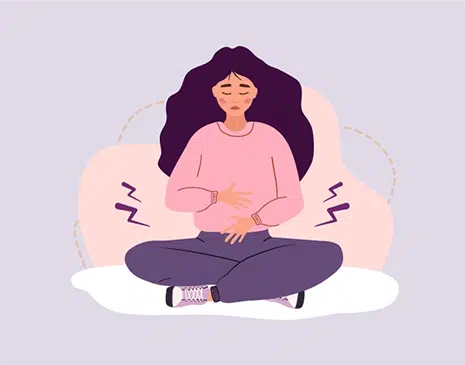Menstruation can manifest in different ways for different women. While many women glide through pain-free monthly bleeds (hallelujah), many women deal with days, weeks, months, or even years of painful period cramps. You know what we’re talking about. Those throbbing, aching, stabbing, somewhat debilitating pains in the abdomen.
Period cramps arrive as a symptom of premenstrual syndrome (PMS) and can stick around for a few days into your bleed. They’re the reason you skip the gym, call in sick for work, resort to meal delivery services, and conform to a horizontal state in bed for a few days every month. So, let’s show period cramps who’s boss by learning everything there is to know about dysmenorrhea (that’s right, period cramps, we know your proper name).
What is dysmenorrhea?
Dysmenorrhea is a condition characterised by frequent and severe menstrual cramps and pain. One of the most common gynaecological problems experienced by women, dysmenorrhea affects between 16% and 91% of women of reproductive age, with 2% to 29% observing severe pain. There are two types of dysmenorrhea: primary dysmenorrhea and secondary dysmenorrhea.
What’s the difference between primary and secondary dysmenorrhea?
Primary dysmenorrhea is the term for recurrent period cramps that aren’t caused by other conditions or diseases. Pain linked to primary dysmenorrhea normally begins a few days before your period arrives, or on the first day of your bleed. Pain may be mild to severe, and radiate through the lower abdomen, back, and thighs. Pain will generally subside after 12 to 72 hours; however, it can lead into other symptoms like nausea, vomiting, and diarrhea.
Secondary dysmenorrhea is the term for painful periods caused by another medical condition, like endometriosis or pelvic inflammatory disease. Pain associated with secondary dysmenorrhea normally begins earlier in the menstrual cycle and lasts longer than primary dysmenorrhea.
What are the symptoms of dysmenorrhea?
Common symptoms of dysmenorrhea include nausea, bloating, diarrhea, constipation, vomiting, indigestion, and cramping. Less common symptoms of dysmenorrhea include irritability, headache, and lower back pain. Symptoms of dysmenorrhea’s can have a negative impact on a woman’s quality of life, work productivity, mental health, and physical health.
What causes dysmenorrhea?
The strongest theory to support the cause of primary dysmenorrhea relates to an increase in the level of prostaglandin hormones. During the menstruation phase of your cycle, an increase in prostaglandin triggers uterine contractions to shed the uterine lining. These contractions cause dysmenorrhea, with intensity being proportionate to the amount of prostaglandins released.
Secondary dysmenorrhea is caused by an underlying disease, disorder, or structural abnormality of the uterus. Common causes of secondary dysmenorrhea include endometriosis, fibroids, adenomyosis, pelvic inflammatory disease, and endometrial polyps.
What are the risk factors of dysmenorrhea?
Risk factors that increase the risk of painful period cramps include:
- Being under 20 years of age
- Having a family history of dysmenorrhea
- Heavy menstrual bleeding
- Irregular periods
- Longer periods
- Smoking
- Higher body mass index
- Attempts to lose weight
- Depression and anxiety
How to treat dysmenorrhea?
Anti-inflammatory painkillers can be taken as a first line of defence against painful period cramps. Next up, heat is a super effective method of relief without any side effects (just be cautious of burning). And of course, painkillers and heat can be used together as a powerful period cramp-killing combo.
Alternatively, the oral contraceptive pill (OCP) helps to decrease the production of prostaglandins, resulting in reduced period pain. In fact, oral contraceptive users experience dysmenorrhea significantly less than non-users.
How can you prevent dysmenorrhea?
In terms of preventing or decreasing the severity of future dysmenorrhea, maintaining an active lifestyle with a balanced diet rich in vitamins and minerals will prove beneficial. If taking oral contraceptives for period pain relief is something you’re interested in, we are here to help! Chat with one of trusted Aussie doctors, today.













